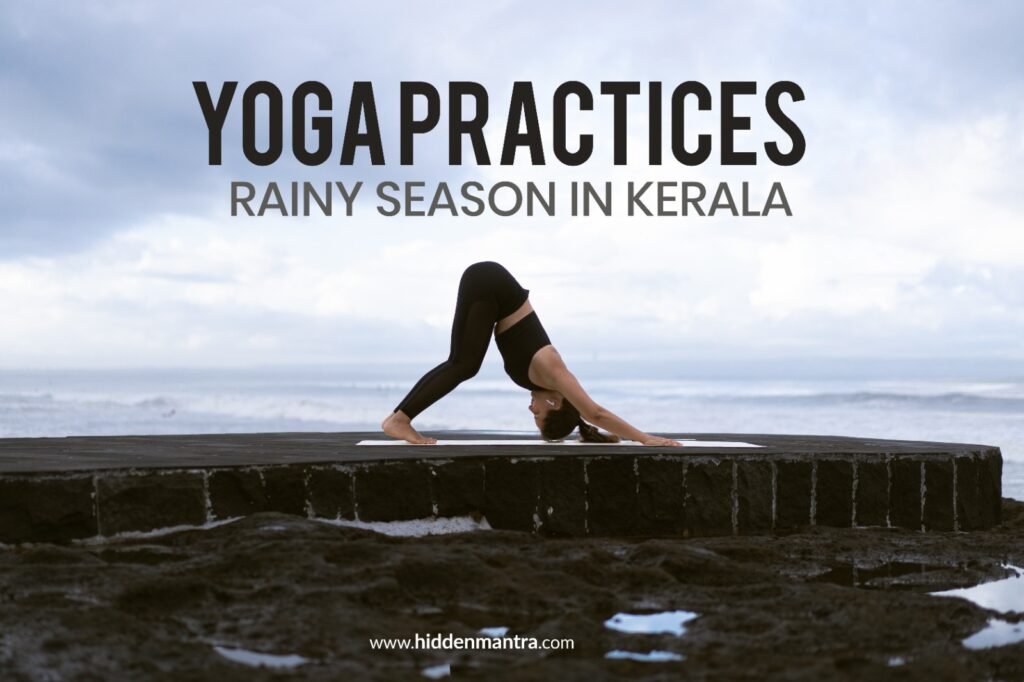Table of Contents
ToggleDuring the monsoon months from June to September, Kerala comes alive with vibrant greenery, mist-covered hills, and a refreshing atmosphere that transforms the entire landscape into a tropical paradise. The hypo-humid climate and frequent rain showers create a fresh ambiance but the dampness brings health challenges like joint stiffness, cold, and low vitality. Explore the benefits of yoga practice in Kerala during the rainy season to boost immunity, balance energy, and enhance overall well-being.
Understanding the Rainy Season and Its Effects on Body and Mind
Kerala’s rainy season, known as the monsoon, typically arrives in early June and lasts through September, bringing with it refreshing rains, lush greenery, and cooler temperatures. However, this season also brings along some unique challenges for the human body and mind that must be addressed through mindful living and holistic practices like yoga.
The constant rainfall leads to increased humidity and dampness, which can affect both physical health and mental balance. The air becomes heavier, and the body’s natural heat tends to diminish, creating an imbalance in the doshas especially Kapha and Vata.
Some of the most common effects during the monsoon include:
- Poor digestion and low hunger caused by a weakened digestive fire (Agni) are common during the rainy season.
- Joint stiffness, body aches, and muscle cramps, particularly for those with pre-existing issues like arthritis or low immunity.
- Build-up of toxins (Ama) occurs in the body when its natural detox processes become sluggish.
- Increased Kapha dosha, leading to mucus build-up, cough, and cold.
- Mood swings, anxiety, and seasonal blues, caused by lack of sunlight and isolation during heavy rains.
- Trouble sleeping and feeling tired throughout the day can make it difficult to maintain regular habits and stay consistent with your daily routine.
- Skin issues, such as fungal infections, due to damp clothing and reduced sun exposure.
Yoga practice in Kerala during the rainy season should be adjusted to suit the cooler, damp, and humid atmosphere for better balance and well-being. The focus shifts from intense workouts to warming, cleansing, and grounding yoga practices. Slow-paced asanas, deep breathing (pranayama), and mindfulness are especially important to counteract the heaviness of the season.
By aligning your yoga during monsoon in Kerala with the changing energy of nature, you can not only maintain your health but also find emotional clarity and internal calm. Yoga, when practiced mindfully, acts as a natural antidote to monsoon-related challenges.
Adapting Yoga Practices for Kerala’s Monsoon Months
The monsoon in Kerala brings a calm yet heavy energy, which calls for a shift in your daily yoga routine. Practicing yoga during this season isn’t about intense workouts it’s about restoring warmth, balance, and inner clarity. Traditional routines must adapt to accommodate the increased dampness, humidity, and slower energy of the rainy weather.
Adapting the Yoga Routine to the Rainy Season
Move Slower & With Awareness
The body naturally becomes less agile during the monsoon, and fast or intense movements may strain the joints and muscles. Try doing yoga in a calm and gentle way, focusing more on awareness and slow movements. This helps your body adjust to the cooler, wetter climate while staying grounded and connected to the breath. Mindful movements also help calm the nervous system, which may feel overstimulated during cloudy, rainy days.
Warmth-Building Postures
To combat the internal coolness and kapha aggravation common during the rainy season, focus on warming asanas such as:
- Gentle sun salutations (Surya Namaskar) with modifications
- Twisting postures like Ardha Matsyendrasana to stimulate digestion
- Forward bends to soothe the mind and stretch the spine
- Standing poses like Warrior II and Chair Pose to improve circulation and boost energy
These poses help kindle Agni (digestive fire) and prevent the sluggishness typically experienced in this season.
Deep Breathwork (Pranayama)
Pranayama is especially important during the rainy season to strengthen lung function and immunity. The humid air can affect respiratory health, so practicing:
- Anulom Vilom, also known as alternate nostril breathing, helps open your nasal passages and brings a sense of calm by balancing the body’s inner energy flow.
- Bhramari (bee breath) calms the mind and helps with seasonal anxiety
- Kapalabhati (skull-shining breath) helps clear toxins and improve metabolic rate
Breath control not only supports physical well-being but also balances mental clarity, which often feels clouded during overcast monsoon days.
Meditative Practices & Relaxation
Adding daily meditation and mindfulness helps manage seasonal mood changes and promotes emotional resilience. The introspective vibe of the rainy season is perfect for developing inner awareness, reducing stress, and improving sleep quality.
Oil Massage (Abhyanga) Before Yoga
A quick Abhyanga (self-massage) with warm sesame oil before your yoga session helps counteract joint stiffness and supports better flexibility during practice. It also improves blood circulation, calms the Vata dosha, and protects the skin from damp air.
Why This Shift Matters
Adapting your yoga practices in the rainy season ensures your sessions remain energizing and therapeutic, not draining. Instead of pushing through sluggishness, you’re working with your body and environment. These mindful adjustments allow you to enjoy the monsoon’s peaceful rhythm while staying healthy and active.
By integrating these changes, yoga during monsoon in Kerala becomes not just exercise but a form of preventive healing, making your yoga Practice more attuned to nature’s seasonal flow.
Recommended Yoga Practices for Rainy Season in Kerala
Doing yoga in Kerala’s rainy season helps you stay calm, healthy, and balanced inside and out. The soothing rain, combined with mindful yoga, creates the perfect environment for healing and inner peace. The cool, damp weather can increase sluggishness, joint discomfort, and digestive problems especially for those with dominant Kapha or Vata doshas. A well-adapted yoga routine helps stimulate energy, improve circulation, and support respiratory health.
- Best Yoga Asanas (Poses) for Rainy Weather
In this season, warming and grounding poses are ideal. Focus on slow, steady movements to energize the body and boost metabolism.
- Modified Surya Namaskar (Sun Salutation)
Perform at a slower pace with deeper breaths. This energizing sequence boosts circulation, warms up cold muscles, and awakens the digestive fire (Agni), which is often weak during monsoons. - Bhujangasana (Cobra Pose)
This gentle backbend opens the chest, improves spinal flexibility, and supports respiratory health especially helpful during the damp season when colds and congestion are common. - Vrikshasana (Tree Pose)
This balancing posture promotes stability, enhances focus, and strengthens the legs. It’s particularly beneficial for combating mental fog and lethargy caused by monsoon weather. - Trikonasana (Triangle Pose)
A great pose to aid digestion, release tight hips, and stretch the side body. It also improves spinal alignment and stimulates abdominal organs. - Marjaryasana-Bitilasana (Cat-Cow Pose)
This dynamic flow between arching and rounding the spine lubricates the joints, especially the spine and shoulders, making it ideal for rainy-season stiffness. - Utkatasana (Chair Pose) – Optional addition
Strengthens the legs and improves endurance. Practicing it during the rainy season helps keep the lower body warm and active.
2. Pranayama (Breath Control Techniques)
Monsoon air tends to be heavy and damp, which may affect your lungs and energy levels. Practicing pranayama during this season supports immunity, clears nasal passages, and boosts mental clarity.
- Anulom Vilom (Alternate Nostril Breathing)
Balances the left and right brain hemispheres, calms the nervous system, and supports lung function. Doing this for just 5 to 10 minutes each day can calm your mind, reduce stress, and bring your doshas into better balance. - Bhramari (Humming Bee Breath)
Known for its calming vibrations, Bhramari reduces stress and mental agitation. It’s a soothing technique for rainy days when the mood may feel heavy or dull. - Kapalbhati (Shining Skull Breath)
A powerful cleansing breath that stimulates digestion, removes toxins (Ama), and clears respiratory channels. Best practiced in the morning on an empty stomach to energize the body. - Sheetkari or Sheetali (Cooling Breath) – Optional on humid days
These techniques cool the body and calm the mind useful if the humidity causes irritability or headaches.
3. Meditation & Mindfulness Practices
The rainy season is perfect for turning inward. Meditation helps settle the mind, enhance mood, and reduce the seasonal blues often caused by less sunlight and reduced outdoor activity.
- Guided Inner Awareness
Spend 10–15 minutes in seated meditation. Focus on breath or follow a guided body scan. This helps improve concentration and emotional regulation. - Nature Visualization or Sound Meditation
Use the soothing sound of rain or visualize serene green landscapes to connect with nature and feel grounded. These practices are known to uplift mood and reduce symptoms of seasonal affective disorder (SAD). - Journaling & Affirmations
Pair your mindfulness practice with gratitude journaling or positive affirmations for an added emotional reset during the monsoon.
Benefits of Practicing Yoga During Kerala’s Rainy Season.
Practicing yoga during the monsoon in Kerala offers several unique health benefits, especially when aligned with seasonal changes and Ayurvedic principles. The cool, moist environment of Kerala’s rainy season may slow down your metabolism and cause physical discomfort, but a well-adapted yoga routine in the rainy season can help you regain balance and vitality.
- Improved Digestion & Metabolism
Warming yoga poses help activate Agni, the body’s digestive fire, which often slows down during the rainy season due to damp and cool weather. These poses boost internal heat, support digestion, and keep energy levels balanced even on gloomy monsoon days.Regular practice helps reduce bloating, indigestion, and heaviness by supporting digestive health naturally.
- Relief from Joint Pain & Muscle Stiffness
Due to increased moisture and reduced activity, joints may feel stiff or achy. Gentle stretches, such as Trikonasana and Cat-Cow Pose, help improve flexibility and lubricate joints, offering relief from monsoon-related stiffness.
- Boosted Immunity & Respiratory Health
The rainy season often leads to colds, sinus issues, and coughs. Pranayama techniques like Anulom Vilom and Kapalabhati cleanse the respiratory system and increase lung capacity, helping build natural immunity during monsoon.
- Enhanced Mental Clarity & Focus
Cloudy skies and staying indoors often lower your energy and make it harder to stay motivated. Mindful yoga combined with meditation and breathwork promotes mental clarity, emotional stability, and reduces anxiety, which is common in monsoon weather.
- Better Sleep & Relaxation
Practicing yoga in the evening or before bed, especially during rainy nights, helps relax the nervous system and improve sleep quality, which may be disrupted due to erratic weather patterns.
- Balanced Energy & Mood Regulation
Seasonal sluggishness is countered by energizing asanas like Surya Namaskar and light twists, which uplift your mood and keep you active throughout the day.
- Detoxification Support
Monsoon is considered an ideal season for detoxification in Ayurveda. The combination of gentle movement and deep breathing during this time helps the body release ama (toxins), promoting better digestion, improved immunity, and overall balance. The moist, cooler climate opens up the body’s channels, making it easier to cleanse and reset your internal systems naturally.
- Increased Self-Awareness & Mindfulness
With fewer outdoor distractions during the rains, it’s a great time to turn inward. Daily yoga helps cultivate self-discipline, mindfulness, and inner peace, aligning your lifestyle with nature’s rhythm.
Practical Tips for Safe Monsoon Yoga in Kerala
Practicing yoga during the monsoon season in Kerala can be refreshing and healing, but it’s important to make a few changes to your routine for safety, comfort, and effectiveness. Here are some practical tips to help you maintain a consistent and safe yoga practice in rainy weather:
1. Practice at the Right Time
- Ideal time: Between 7:00 AM and 9:00 AM, after sunrise.
- This is when humidity levels are more stable, and the body is naturally more awake and ready.
- Practicing early in the morning also aligns with Ayurvedic body rhythms (dinacharya) and helps boost energy and mood throughout the day.
2. Choose the Right Location
- Practice in a well-ventilated, dry, and warm space indoors.
- Avoid open balconies, damp floors, or shaded gardens during rain.
- A yoga room with wooden or anti-slip mats is ideal during the monsoon.
3. Wear Suitable Clothing
- Use moisture-wicking and breathable fabrics like cotton blends or bamboo.
- Avoid heavy or tight-fitting clothes that trap sweat or make you feel cold.
- Consider wearing light layers you can remove as your body warms up.
4. Stay Hydrated the Right Way
- Drink warm water or herbal teas like ginger, tulsi, or cinnamon before and after your practice.
- Avoid cold drinks, as they can weaken digestion and increase Kapha dosha, which is already elevated in rainy weather.
- Hydration supports flexibility and prevents muscle cramps during yoga.
5. Keep Your Space Clean & Dry
- After each session, wipe down your yoga mat and props to prevent mold and dampness.
- Store your mat in a dry and elevated place.
- Consider using anti-bacterial sprays or essential oils like tea tree or eucalyptus to clean and freshen your space.
6. Use Light and Aromatherapy for Ambience
- Light a natural incense stick or use essential oil diffusers like lemongrass, lavender, or camphor.
- This not only brightens your mood but also purifies the air and refreshes your senses, making even cloudy, rainy mornings feel uplifting and energizing.
7. Be Mindful of Joint Sensitivity
- Monsoon season often brings joint stiffness and muscle soreness.
- Start with gentle stretches or warm-up exercises like Cat-Cow Pose (Marjaryasana-Bitilasana) before deeper poses.
- Avoid high-impact or overly strenuous movements when the weather is damp.
Conclusion
Making changes to your yoga practice during the rainy season in Kerala is a wise and healthy decision. The monsoon brings beauty, freshness, and calm, but it can also affect your body with tiredness, joint pain, or weak digestion. That’s why following a yoga routine that matches the season can help you feel more active, strong, and balanced.
By practicing gentle yoga poses, warming pranayama, and following Ayurvedic self-care tips, you can protect yourself from common rainy season issues. Small changes like doing yoga in a dry place, drinking warm herbal tea, and focusing on your breath make a big difference.
The rainy season is a great time to slow down, connect with yourself, and build a stronger mind-body connection. It’s also perfect for exploring monsoon yoga retreats, Panchakarma therapies, or joining a guided wellness program.
Want to learn more? Visit HiddenMantra for insightful articles, expert guidance, and personalized Ayurvedic yoga practices tailored for every season. Embrace the monsoon with natural peace, strength, and harmony.
Visit HiddenMantra for helpful articles, expert tips, and customized Ayurvedic yoga practices for every season. Embrace the monsoon with peace, strength, and harmony naturally.









